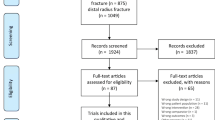Abstract
Introduction: Physiotherapy is considered by some authorities to be an important aspect of management in patients following distal radius fractures. There is evidence of improvement in impairment with physiotherapy; however, there is no evidence to support early return of functional activity. Traditional physiotherapy management has focussed on improving impairment; however, there are no trials with emphasis on skill acquisition via motor re-learning principles. Materials and methods: Forty-one participants with conservatively managed distal radius fractures were studied in a randomised, single-blinded, prospective trial. Two treatment options were compared: exercise and advice versus activity-focussed physiotherapy with measurement periods of 6 weeks after removal of cast and follow-up at 24 weeks. Results: Participants allocated to the exercise and advice group consulted a physiotherapist an average of 0.9 (SD 0.4) times, while the participants allocated to the more intensive activity-focussed group consulted with physiotherapy a mean of 4.4 (SD 2.3) times. At both 6 and 24 weeks there were no significant differences between the groups for change in impairment (as measured by grip strength, range of motion of wrist flexion and extension and pain intensity), activity limitation and participation restriction, as measured by the Patient-Rated Wrist Evaluation (PRWE). Exercise and advice given by a physiotherapist were equally as effective as activity-focussed physiotherapy in recovery both at 6 and 24 weeks. Conclusion: The results suggest that after removal of cast from fracture of distal radius, patients may routinely require no more than a single session of advice and exercise provided by a physiotherapist.

Similar content being viewed by others
References
Carr J, Shepherd R (1995) Skill learning after musculoskeletal lesions. In: Refshauge K, Gass E (eds) Musculoskeletal physiotherapy: clinical science and practice. Butterworth-Heinemann, Oxford, pp 32–38
Firrell J (1996) Which setting of the dynamometer provides maximal grip strength? J Hand Surg 21(A):397–401
Hollis S, Campbell F (1999) What is meant by intention-to-treat analysis? Br Med J 319:670–674
Jette A (1995) Outcomes research: shifting the dominant research paradigm in physical therapy. Phys Ther 75:965–970
Kay S, Haensel N, Stiller K (2000) The effect of passive mobilisation following fractures involving the distal radius: a randomised study. Aust J Physiother 46:93–101
Laseter G, Carter P (1996) Management of distal radius fractures. J Hand Ther 9(2):114–128
Le Stayo P, Wheeler D (1994) Reliability of passive wrist flexion and extension goniometric measurements: a multicenter study. Phys Ther 74(2):162–176
MacDermid J (1996) Development of a scale for patient rating of wrist pain and disability. J Hand Ther 9:178–183
MacDermid J, Richards R, Roth J (2001) Distal radius fractures: a prospective outcome study of 275 patients. J Hand Ther 14(2):154–169
Maher C, Sherrington C, Herbert R, Moseley A, Elkins M (2003) Reliability of the PEDro scale for rating randomised controlled trials. Phys Ther 83(8):713–721
Maitland G (1991) Peripheral manipulation, 3rd edn. Butterworths, London, pp 6–11
Masud T, Jordan D, Hosking DJ (2001) Distal forearm fracture history in an older community-dwelling population: the Nottingham Osteoporosis (NOCOS) study. Age Ageing 30:255–258
McPhate M, Robertson V (1998) Physiotherapy treatment of colles fractures: hands on or hands off. In: Proceedings of the fifth international Australian physiotherapy association congress, Hobart, p 235
Muller M, Nazarian S, Koch P et al (1990) The comprehensive classification of fractures of long bones. Springer, Berlin Heidelberg New York
Oskarsson G, Hjall A, Aaser P (1997) Physiotherapy: an overestimated factor in after-treatment of fractures in the distal radius? Arch Orthop Trauma Surg 116(6–7):373–375
Sheehan N, Sheldon J, Marks D (1983) Grip strength and torquometry in the assessment of hand function in patients with rheumatoid arthritis. Br J Rheumatol 22:158–164
Taylor N, Bennell K (1994) The effectiveness of passive joint mobilisation on the return of active wrist extension following Colles fracture: a clinical trial. New Zealand J Physiother 22(1):24–28
Tremayne A, Taylor N, McBurney H et al (2002) Correlation of impairment and activity after wrist fracture. Physiother Res Int 7(2):90–99
Veldman P, Reynan H, Arntz I et al (1993) Signs and symptoms of reflex sympathetic dystrophy: prospective study of 839 patients. Lancet 342:1012–1016
Wakefield A, McQueen M (2000) The role of physiotherapy and clinical predictors of outcome after fracture of distal radius. J Bone Joint Surg 82B:972–976
Watt C, Taylor N, Baskus K (2000) Do colles fracture patients benefit from routine referral to physiotherapy following cast removal? Arch Orthop Trauma Surg 120:413–415
World Health Organisation (2001) ICF: international classification of functioning, disability and health: short version. World Health Organisation, Geneva
Acknowledgements
The authors thank Lyndell Keating, Manager of Physiotherapy Services, and the orthopaedic physiotherapy team for support of the project.
Author information
Authors and Affiliations
Corresponding author
Rights and permissions
About this article
Cite this article
Maciel, J.S., Taylor, N.F. & McIlveen, C. A randomised clinical trial of activity-focussed physiotherapy on patients with distal radius fractures. Arch Orthop Trauma Surg 125, 515–520 (2005). https://doi.org/10.1007/s00402-005-0037-x
Received:
Published:
Issue Date:
DOI: https://doi.org/10.1007/s00402-005-0037-x




